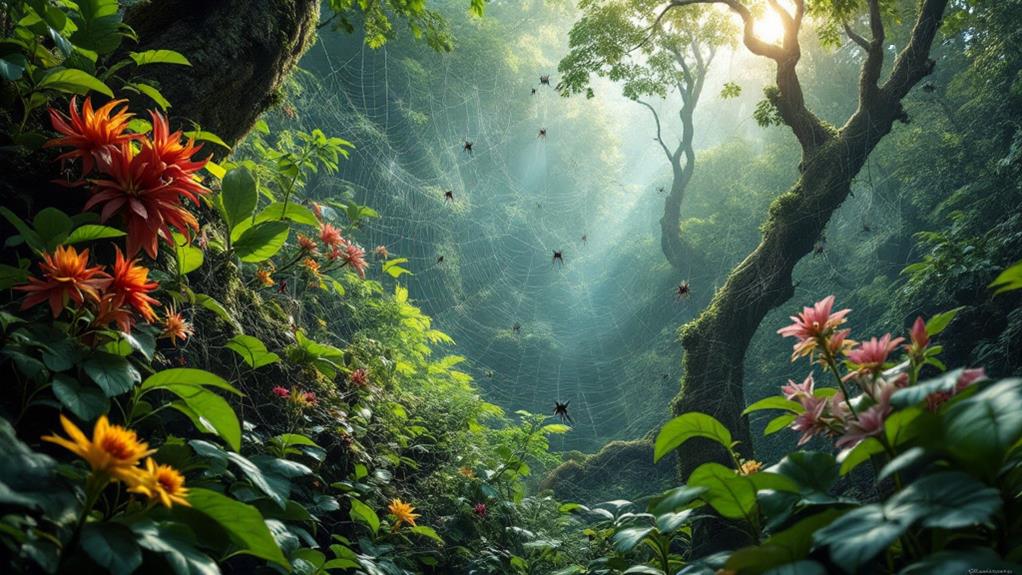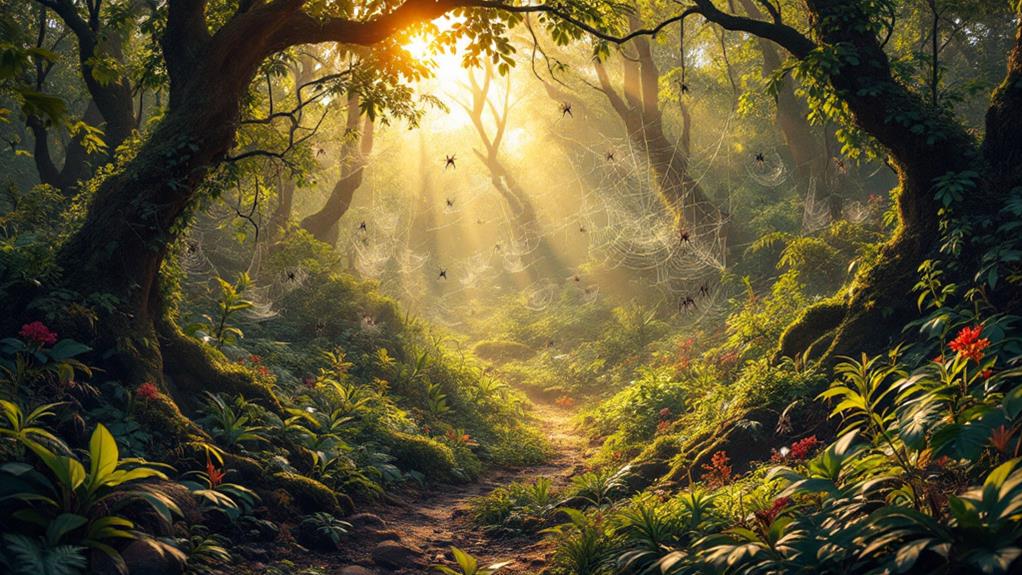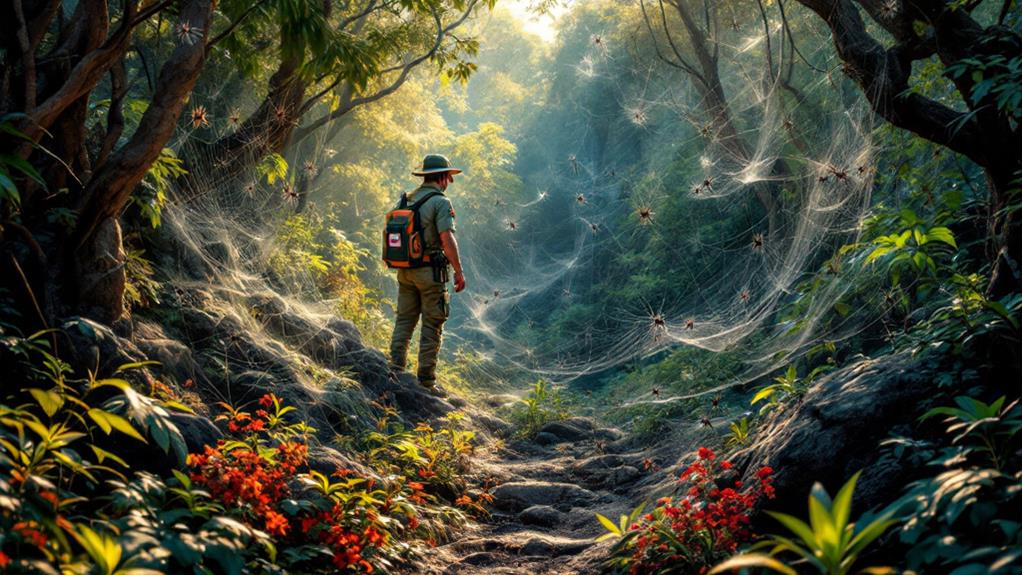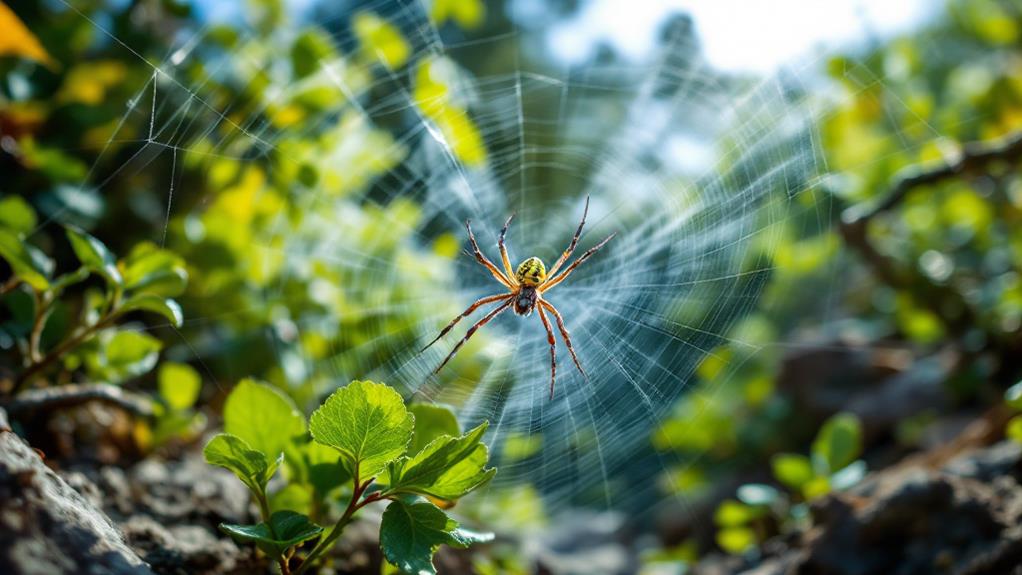Why Does Australia Have So Many Spiders? A Look at the Country’s Wildlife

Australia's teeming spider population results from its long evolutionary history and varied environments. With over 10,000 unique species, each adapted to habitats from deserts to rainforests, these arachnids play crucial roles in pest control and biodiversity. Australia's separation from Gondwana led to the evolution of spiders with advanced adaptations like potent venom and sophisticated web structures. You'll find spiders, including the dangerous Sydney Funnel-web and the harmless Huntsman, sharing space with humans, where they help control pests. This relationship underscores the ecological balance spiders maintain. If you're curious about more intricate aspects of their behavior and roles, there are deeper insights ahead.
Diversity of Australian Spiders
Australia frequently showcases an incredible diversity of spiders, with over 10,000 unique species plunging this continent home. This staggering variety stems from its unique wildlife and the continent's wide range of diverse habitats, from scorching deserts and lush rainforests to lively urban areas. Each environment has fostered the development of distinct spider species, including many endemic species found nowhere else on Earth.
Among these, you'll find both venomous species and those that pose no threat to humans. The Sydney Funnel-web Spider and the Redback Spider are notable for their potent venom, making them infamous in tales of Australia's wildlife. Yet, not all spiders are dangerous. The Huntsman Spider, for example, is large and often feared due to its size, but it's generally harmless to humans.
Australia's specialized habitats, such as caves, further contribute to the evolution of unique spider species, enhancing the ecological richness of this region. These spiders' evolutionary history is deeply entwined with Australia's landscape, with fossils dating back 300 million years. This long history has shaped a complex web of life, where spiders play essential roles in maintaining ecological balance.
Evolutionary History of Arachnids
While exploring the remarkable diversity of Australian spiders, it's important to understand the evolutionary history that shaped these creatures. Australia, separated from the ancient supercontinent Gondwana about 100 million years ago, provided a unique platform for the evolution of over 10,000 spider species, with more than 3,000 identified today. The isolation allowed these arachnids to adapt to the continent's varied habitats, from deserts to rainforests and even urban landscapes, leading to the development of distinct traits vital for survival.
The oldest spider fossils in Australia date back approximately 300 million years, reflecting a long and intricate evolutionary history. This extensive timeline has resulted in many endemic species, found nowhere else but in Australia, highlighting the geological and environmental factors influencing their evolution. These conditions fostered a rich tapestry of unique species that contribute notably to Australia's biodiversity.
A fascinating aspect of their evolutionary success in diverse habitats is the ballooning mechanism, where young spiders disperse by air. This method aids in maintaining and expanding populations across isolated areas, further shaping their evolutionary trajectory and ensuring the continued adaptation and survival of these remarkable arachnids in Australia.
Spider Habitats in Australia

How do spiders manage to plunge in such distinct habitats across Australia? With over 10,000 unique spider species, Australia boasts a wide array of habitats, from arid deserts to lush rainforests and lively urban areas. These spiders have adapted to thrive in nearly all terrestrial environments. Each spider species finds its niche, irrespective of it being in your garden, dense forests, or even the intertidal zones. The Australian Museum highlights this incredible diversity, attributing it to multiple factors, including the ancient process of continental drift.
Continental drift has greatly shaped the evolution of distinct spider species in Australia. As landmasses shifted, isolated populations adapted to their unique environments, leading to the high number of endemic species you see today. However, climate change poses a new threat, disrupting these natural habitats and presenting challenges for spider populations. Habitat destruction and shifts in climate can lead to genetic bottlenecks, particularly in isolated regions.
In urban areas, spiders often adapt by changing their web construction techniques to optimize food capture, responding to the availability of prey and environmental conditions. Despite the challenges, Australia's spiders continue to find ways to survive and flourish in their distinct habitats.
Spider Adaptations and Traits
Imagine walking through the diverse landscapes of Australia and encountering the incredible adaptations of its spider inhabitants. With over 10,000 spider species, including more than 3,000 identified, Australia boasts an impressive range of unique adaptations and distinct traits. These spiders have evolved to thrive in varied environments, from arid deserts to lush rainforests.
You'll notice the advanced web-building techniques many spider species employ. With different web types like orb, sheet, and funnel, spiders tailor their structures to suit environmental needs and prey availability. This ingenuity guarantees they efficiently capture food and avoid becoming prey themselves.
- Venomous Spiders: Some species have increased venom potency, essential for both capturing prey and defense.
- Ballooning: A fascinating adaptation where young spiders release silk threads to catch the wind, enabling long-distance travel.
- Specialized Habitats: Unique environments, such as caves, drive the evolution of distinct spider species, enhancing diversity.
These adaptations highlight the remarkable ways spiders have evolved to meet the challenges of their surroundings. So, when you investigate Australia's wild landscapes, remember you're witnessing a world of spiders with unparalleled adaptability and survival strategies.
Ecological Roles of Spiders

Australia's spiders play essential ecological roles, acting as natural pest controllers by keeping insect populations in check. By reducing crop damage, they contribute to ecosystem balance, which is fundamental for maintaining a healthy environment. When you think about how spiders help maintain biodiversity, it's clear they're crucial to supporting food chains. They function as both predators and prey, ensuring that the complex web of life remains intact.
You might find it fascinating that these eight-legged creatures, often misunderstood as mere venomous animals, are important for the conservation of their habitats. Their presence indicates a healthy ecosystem, and they serve a greater purpose than you might initially realize. Spiders' intricate webs, which showcase stunning architectural designs, also add to the natural beauty around you and vary based on environmental needs.
Moreover, spiders aren't just vital for pest control and biodiversity—they're valuable in medical research and biotechnology. Their venom and silk properties are under study for potential groundbreaking applications. However, habitat destruction poses a threat. Conserving spider habitats is crucial to ensuring their populations thrive and continue contributing to our ecosystem's health. By recognizing their roles, you support their conservation and the well-being of Australia's diverse wildlife.
Human-Spider Interactions
Spiders often find themselves sharing spaces with humans across Australia, from gardens to homes and sheds, where they quietly perform the valuable task of natural pest control. Australia is home to a wide range of spider species, most of which are harmless and play an essential role in controlling insect populations. While encounters with these spiders are common, understanding their behavior can turn fear into fascination and foster a sense of coexistence.
Here are some key points to reflect on:
- Diverse Species: Australia is home to both harmless and venomous spider species. Knowledge about these can help reduce unnecessary fear.
- Public Awareness: Educating yourself about local spider species increases appreciation for biodiversity and encourages safer interactions.
- Spider Safety Measures: Simple practices like checking shoes and outdoor gear can prevent bites and promote peaceful coexistence.
Thanks to effective antivenoms for venomous spiders like the Redback and Funnel-web, the risk of serious harm is minimized. Public awareness initiatives emphasize the importance of education in spider safety measures. As urbanization threatens spider habitats, conservation efforts become essential to maintain healthy ecosystems. By learning and respecting these fascinating creatures, you can coexist peacefully while enjoying the benefits they bring to your environment.
Venom and Safety Measures

Encountering a spider in your home or garden might trigger a moment of anxiety, but understanding venomous species and safety measures can put your mind at ease. Australia hosts several venomous spiders, like the Sydney funnel-web spider, known for its potent neurotoxins. However, with appropriate knowledge, the risk of bites is minimal. Most spiders you encounter are harmless and actually play a beneficial role in controlling insect populations.
Awareness is your primary line of defense. Knowing the local spider species and their behavior can greatly reduce bite risks. Just like with venomous snakes, a bit of education goes a long way. You can adopt simple safety measures, such as checking your shoes, shaking out clothing, and avoiding touching webs, to prevent unwanted encounters.
If an unfortunate bite occurs, rest assured that effective antivenom is available. Since 1980, no fatalities from funnel-web or redback spider bites have been reported, thanks to advancements in medical treatment. Public education on spider behavior and habitat improves understanding, encouraging coexistence and reducing fear. By arming yourself with knowledge and taking simple precautions, you can safely share your environment with these fascinating creatures.
Web Construction and Uses
Understanding venomous spiders and safety measures empowers you to appreciate the remarkable world of web construction by these fascinating creatures. Australian spiders master web construction with a variety of web types, including orb, sheet, and funnel designs. Each type is distinctly adapted to suit their environment and the prey they hunt. Spider silk, known for its incredible strength—stronger than steel of the same thickness—is the key material in these constructions. It's produced by spinnerets and serves multiple purposes: creating webs, wrapping prey, and forming safety lines.
Spiders in Australia have evolved distinctive adaptations in their web designs, allowing them to thrive in diverse habitats. From lively urban areas to the secluded bushland, these webs are not just functional; they also improve hunting efficiency. Spiders can adjust the size and structure of their webs based on food availability, optimizing their capture success in different conditions.
Consider these fascinating points:
- Web Types: Tailored designs improve survival in specific environments.
- Spider Silk: Provides a multifunctional tool for web creation and prey capture.
- Distinct Adaptations: Enable survival across a range of habitats, showcasing nature's engineering marvels.
Spider Species and Identification

Australia's rich tapestry of spider species invites both fascination and caution. With over 10,000 unique spider species, more than 3,000 have been identified and many are endemic to the region. This staggering biodiversity is largely due to Australia's varied environments, from arid deserts to lush rainforests, which have fostered specialized adaptations in these creatures. These adaptations allow spider species to flourish in diverse habitats, each exhibiting unique traits that make them intriguing to study.
When it comes to identification, you'll often rely on specific characteristics such as web structure, body size, color patterns, and behavior. For instance, the highly venomous Sydney Funnel-web Spider is known for its aggressive demeanor and powerful venom, making its identification vital for safety. The Redback Spider, with its distinctive red stripe, is another species to watch out for, while the large yet generally harmless Huntsman Spider often surprises with its size.
Understanding these spiders isn't just about avoiding them; it's about appreciating their ecological roles. Public interest in these fascinating creatures promotes conservation and highlights their importance in pest control and maintaining biodiversity. So, next time you spot a spider, remember its unique place in Australia's ecosystem.




